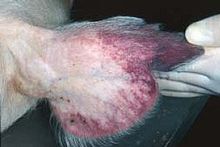This article is missing information about genome variability regions. (December 2020) |
| African swine fever virus | |
|---|---|

| |
| Electron micrograph of a virus particle | |
| Virus classification | |
| (unranked): | Virus |
| Realm: | Varidnaviria |
| Kingdom: | Bamfordvirae |
| Phylum: | Nucleocytoviricota |
| Class: | Pokkesviricetes |
| Order: | Asfuvirales |
| Family: | Asfarviridae |
| Genus: | Asfivirus |
| Species: | African swine fever virus
|

African swine fever virus (ASFV) is a large, double-stranded DNA virus in the Asfarviridae family.[1] It is the causative agent of African swine fever (ASF). The virus causes a hemorrhagic fever with high mortality rates in domestic pigs; some isolates can cause death of animals as quickly as a week after infection. It persistently infects its natural hosts, warthogs, bushpigs, and soft ticks of the genus Ornithodoros, which likely act as a vector, with no disease signs.[2] It does not cause disease in humans.[3][4] ASFV is endemic to sub-Saharan Africa and exists in the wild through a cycle of infection between ticks and wild pigs, bushpigs, and warthogs. The disease was first described after European settlers brought pigs into areas endemic with ASFV, and as such, is an example of an emerging infectious disease.
ASFV replicates in the cytoplasm of infected cells.[1] It is the only virus with a double-stranded DNA genome known to be transmitted by arthropods.[5]
- ^ a b Dixon; et al. (2008). "African Swine Fever Virus". Animal Viruses: Molecular Biology. Caister Academic Press. ISBN 978-1-904455-22-6.
- ^ Denyer, M. S.; Wilkinson, P. J. (1998). "African Swine Fever". Encyclopedia of Immunology. p. 54. doi:10.1006/rwei.1999.0015. ISBN 9780122267659. S2CID 69033207.
- ^ "African swine fever". European Food Safety Authority. Retrieved 26 April 2019.
- ^ Smriti Mallapaty (25 April 2019). "Spread of deadly pig virus in China hastens vaccine research". Nature. 569 (7754): 13–14. Bibcode:2019Natur.569...13M. doi:10.1038/d41586-019-01269-5. PMID 31040406.
- ^ Gaudreault, Natasha N.; Madden, Daniel W.; Wilson, William C.; Trujillo, Jessie D.; Richt, Juergen A. (2020). "African Swine Fever Virus: An Emerging DNA Arbovirus". Frontiers in Veterinary Science. 7: 215. doi:10.3389/fvets.2020.00215. PMC 7237725. PMID 32478103.